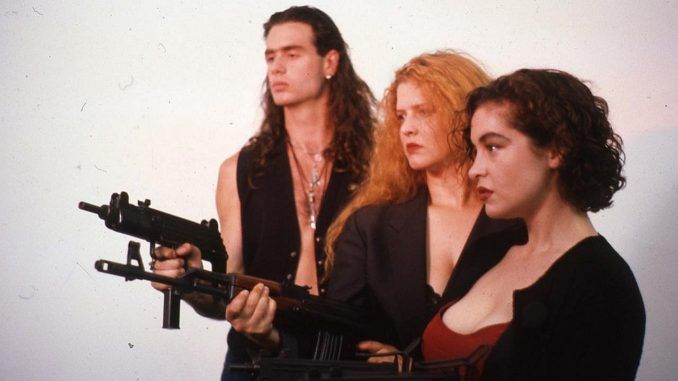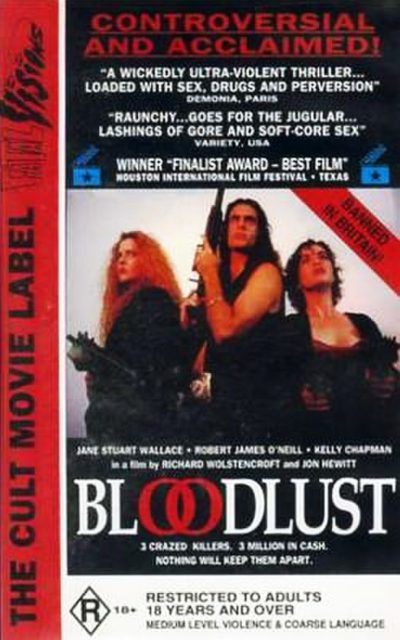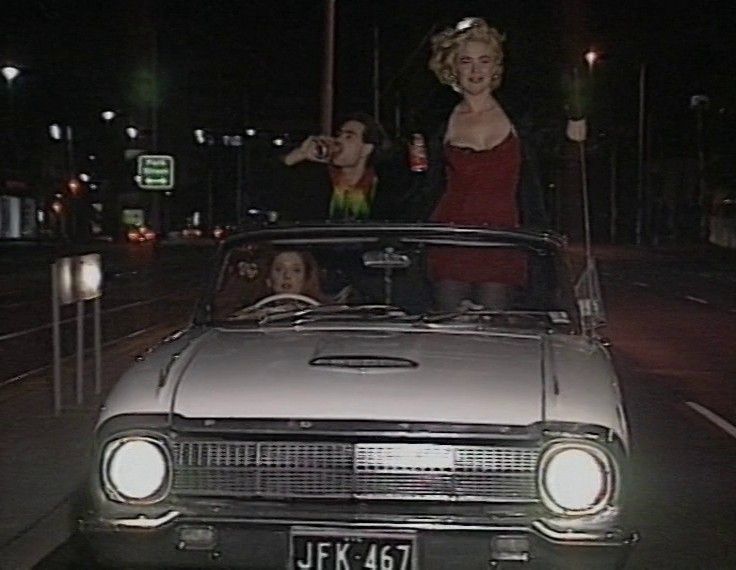
Rating: C
Dir: Jon Hewitt, Richard Wolstencroft
Star: Jane Stuart Wallace, Kelly Chapman, Robert James O’Neill, Phil Motherwell
“This feels like a Brain Damage film,” said Chris a few minutes into it, and she’s not wrong. It’s the kind of energetically cheap movie in which that company seems to specialize, though this predates their founding by the best part of a decade, and is from the other side of the globe, in Australia. Some may take the comparison as a warning, and there are elements here which make me understand completely why. Yet it did manage to avoid losing my attention completely, and it’s certainly the only vampire movie in this feature which includes Al Jourgensen, the lead singer of Ministry, in the “Thanks to” section of the end credits. This appreciation is for good reason: we’ll get back to this in a bit.
The other aspect which needs addressing before we get going, is the claim on the sleeve that this was “Banned in Britain.” There’s no evidence that was actually the case: or, at least, the BBFC website contains nothing to indicate the film was ever refused a certificate – basically the definition of “banned” as everyone understands it. It appears what actually happened, was that a copy being shipped to a potential UK distributor got seized by HM Customs and Excise. As someone on the receiving end of this kind of thing, I can tell you that HMC&E in the nineties operated entirely on their own judgment. Many films they seized as “indecent and obscene” actually turned out to be…not so much. Hewitt admits cynically turning this seizure into a positive, saying, “Certainly we milked that like you wouldn’t believe… Got quite a bit of press at the time, I can remember.”
 What we have here is the story of three young vampires. Though they don’t have most of the trapping of their kind: daylight isn’t an issue, crosses seem to have no impact, and if they have fangs, I must have missed them. Being staked through the heart does seem problematic – then again, it would be for me as well. What they do have is an appetite for blood, which they vacuum up from their victims around Melbourne, usually after having sex with them. It’s now a vague menage a trois situation, with Tad (O’Neill) and his two female companions, Frank (Chapman, whose shoot was interrupted by a trial for importing ecstasy – she got a suspended sentence) and Lear (Wallace). There was a fourth vampire, Dee; however, the films opens with him being caught and staked by the religious lynch-mob of Brother Bem (Motherwell).
What we have here is the story of three young vampires. Though they don’t have most of the trapping of their kind: daylight isn’t an issue, crosses seem to have no impact, and if they have fangs, I must have missed them. Being staked through the heart does seem problematic – then again, it would be for me as well. What they do have is an appetite for blood, which they vacuum up from their victims around Melbourne, usually after having sex with them. It’s now a vague menage a trois situation, with Tad (O’Neill) and his two female companions, Frank (Chapman, whose shoot was interrupted by a trial for importing ecstasy – she got a suspended sentence) and Lear (Wallace). There was a fourth vampire, Dee; however, the films opens with him being caught and staked by the religious lynch-mob of Brother Bem (Motherwell).
Realizing they’re flying too close to the flames, the remaining trio decide it’s time to head out of town, but will first still proceed with the original plan to rob a casino. Being, effectively, bulletproof does have its advantages in the world of criminal endeavours. While they succeed in the initial heist, this action draws the attention of Steig, the mob boss who owns the casino, as well as the local cops – even if the latter appear to number no more than two (2). Instead of just being hunted by Brother Bem, there are now three separate groups on the vampires’ tails, and it all culminates with a massive shoot-out in a suburb on the outskirts of Melbourne. Oh, and Dee had kinda-almost survived the staking, albeit in a horrifically mutilated state.
It’s interesting that this combination of vampires and crime came out the same year as Innocent Blood went a somewhat similar route. That was, obviously, a lot more polished: this seems almost to wear its rough and ready nature like a badge of honour. Some of this works reasonably well: the bullets fly in copious number, and unlike modern low-budget films, there’s no crappy CGI muzzle-flashes. The makers here clearly loved the guns, going so far as to give the weapons their own individual section of the end credits. The make-up work on post-stake Dee is also imaginative and gross, and I dug the soundtrack, which appears largely to consist of Ministry side-projects (hence the Jourgensen thanks). In particular, the film uses about half of The Revolting Cocks’ Beers, Steers and Queers album, occasionally to surprisingly decent effect.
 However, for every element that’s fun and/or well-executed, there’s likely two which fail miserably. The cops are firmly in that category, in particular the one who is attempting to put on a truly terrible American accent (and he’s not the only such culprit). I believe most of the cast were amateurs, and being generous, you can typically tell, with few of the performances reaching the level of adequate: underacting or overacting is the order of the day. Motherwell is the obvious exception. He is easily the most accomplished and entertaining actor here, with his zealotry turned up to 11, and fitting the spirit of the movie well. He feels almost cut out of the same pastoral cloth as Father McGruder from another Antipodean horror product of 1992, Braindead: “I kick arse for the Lord!”
However, for every element that’s fun and/or well-executed, there’s likely two which fail miserably. The cops are firmly in that category, in particular the one who is attempting to put on a truly terrible American accent (and he’s not the only such culprit). I believe most of the cast were amateurs, and being generous, you can typically tell, with few of the performances reaching the level of adequate: underacting or overacting is the order of the day. Motherwell is the obvious exception. He is easily the most accomplished and entertaining actor here, with his zealotry turned up to 11, and fitting the spirit of the movie well. He feels almost cut out of the same pastoral cloth as Father McGruder from another Antipodean horror product of 1992, Braindead: “I kick arse for the Lord!”
Indeed, this does feel influenced by Peter Jackson’s work across the Tasman Sea, though is generally less comedic in tone. It also seems…uglier. Not just in terms of the characters, though there’s hardly anybody here even orbiting “likable”. There are films which look like they were made for a much higher budget: this is not one of them. It cost around US$50,000 at the time – twice as much as Jackson’s debut, Bad Taste – reportedly raised from some dodgy gangster-like types. But except for the occasional, rare moment, it looks particularly cheap, and I found myself wondering where exactly that went. Probably mostly on blank ammo and music licensing fees to Wax Trax, I imagine. There are worse ways for a film’s budget to be spent, admittedly.
It’s a purpose-made, market-driven, crass, exploitation film. It isn’t particularly good but, for me, it was really my film school. It’s where I taught myself how to make a feature film and made a lot of mistakes on it – but I tried to learn from them.
— Jon Hewitt
This review is part of our October 2023 feature, 31 Days of Vampires.
